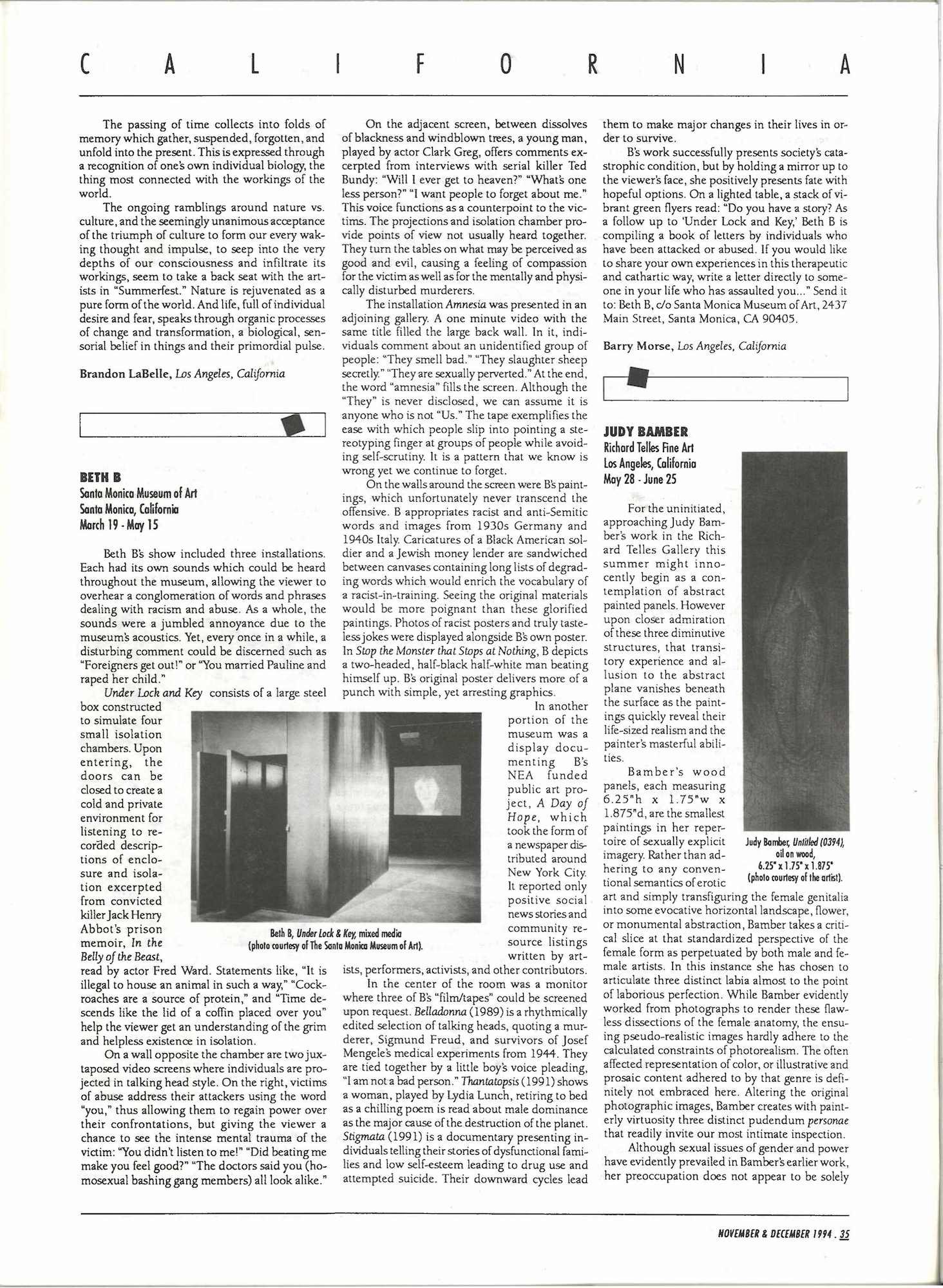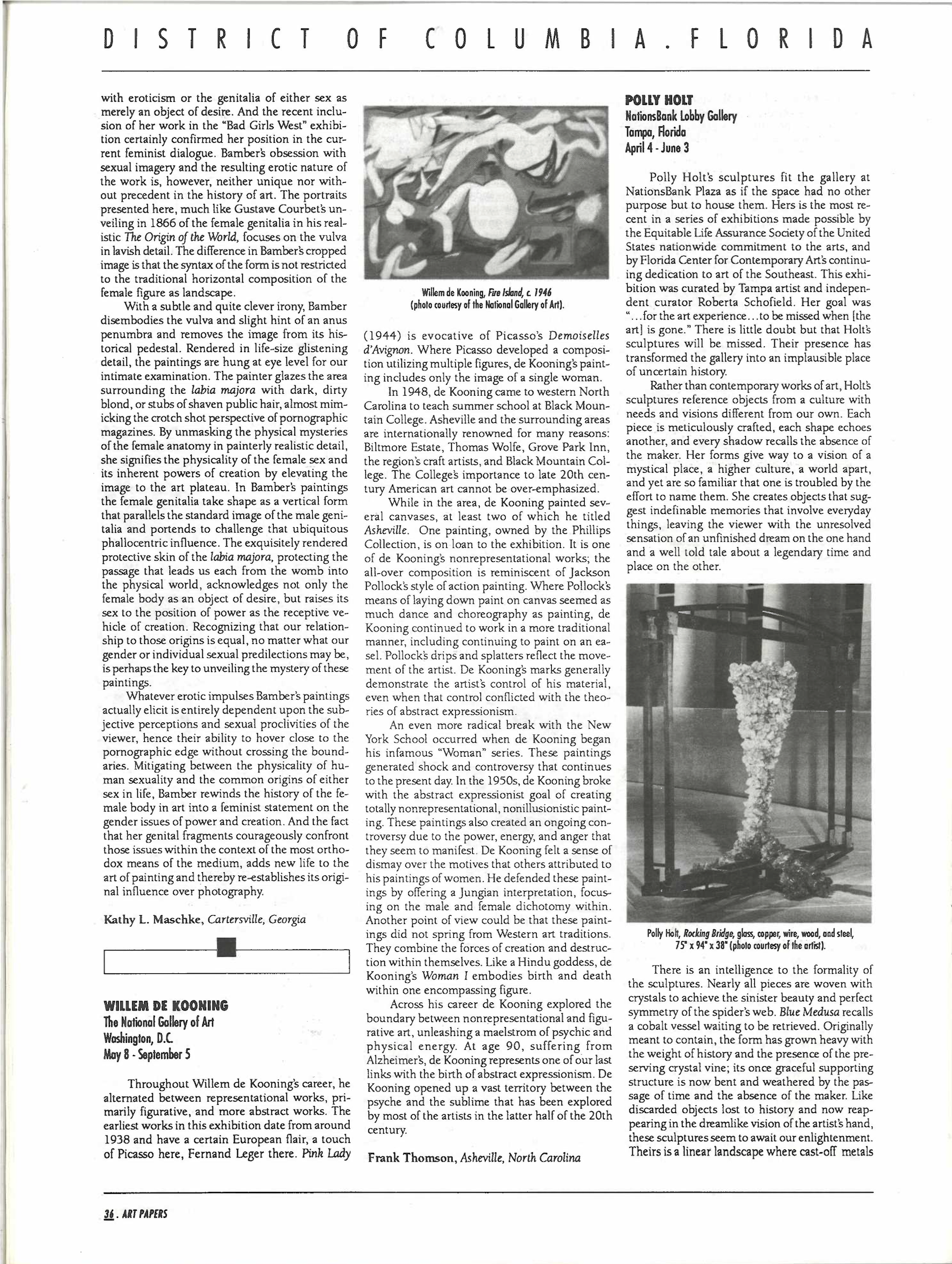Judie Bamber
Share:
For the uninitiated, approaching Judie Bamber’s work in the Richard Telles Gallery this summer might innocently begin as a contemplation of abstract painted panels. However upon closer admiration of these three diminutive structures, that transitory experience and allusion to the abstract plane vanishes beneath the surface as the paintings quickly reveal their life-sized realism and the painter’s masterful abilities. Bamber’s wood panels, each measuring 6.25”h x 1.75”w x 1.875”d, are the smallest paintings in her repertoire of sexually explicit imagery. Rather than adhering to any conventional semantics of erotic art and simply transfiguring the female genitalia into some evocative horizontal landscape, flower, or monumental abstraction, Bamber takes a critical slice at the standardized perspective of the female form as perpetuated by both male and female artists. In this instance she has chosen to articulate three distinct labia almost to the point of laborious perfection. While Bamber evidently worked from photographs to render these flawless dissections of the female anatomy, the ensuing pseudo-realistic images hardly adhere to the calculated constraints of photorealism. The often affected representation of color, or illustrative and prosaic content adhered to by that genre is definitely not embraced here. Altering the original photographic images, Bamber creates with painterly virtuosity three distinctly pudendum personae that readily invite our most intimate inspection.
Although sexual issues of gender and power have evidently prevailed in Bamber’s earlier work, her preoccupation does not appear to be solely with eroticism or the genitalia of either sex as merely an object of desire. And the recent inclusion of her work in the “Bad Girls West” exhibition certainly conformed her position in the current feminist dialogue. Bamber’s obsession with sexual imagery and the resulting erotic nature of the work is, however, neither unique nor without precedent in the history of art. The portraits presented here, much like Gustave Courbet’s unveiling in 1866 of the female genitalia in his realistic The Origin of the World, focuses on the vulva in lavish detail. The difference in Bamber’s cropped image is that the syntax of the form is not restricted to the traditional horizontal composition of the female figure as landscape.
With a subtle and quite clever irony, Bamber disembodies the vulva and slight hint of an anus penumbra and removes the image from its historical pedestal. Rendered in life-size glistening detail, the paintings are hung at eye level for our intimate examination. The painter glazes the area surrounding the labia majora with dark, dirty blond, or stubs of shaven pubic hair, almost mimicking the crotch shot perspective of pornographic magazines. By unmasking the physical mysteries of the female anatomy in the painterly realistic detail, she signifies the physicality of the female sex and its inherent powers of creation by elevating the images to the art plateau. In Bamber’s paintings the female genitalia take shape as a vertical form that parallels the standard image of the male genitalia and portends to challenge that ubiquitous phallocentric influence. The exquisitely rendered protective skin of the labia majora, protecting the passage that leads us each from the womb into the physical world, acknowledges not only the female body as an object of desire, but raises its sex to the position of power as the receptive vehicle of creation. Recognizing that out relationship to those origins is equal, no matter what our gender or individual sexual predilections may be, is perhaps the key to unveiling the mystery to these paintings.
Whatever erotic impulses Bamber’s paintings actually elicit is entirely dependent upon the subjective perceptions and sexual proclivities of the viewer, hence their ability to hover close to the pornographic edge without crossing the boundaries. Mitigating between the physicality of human sexuality and the common origins of either sex in life, Bamber rewinds the history of the female body in art into a feminist statement on the gender issues of power and creation. And the facts that her genital fragments courageously confront those issues within the context of the most orthodox means of the medium, adds new life to the art of painting and thereby re-establishes its original influence over photography.
Kathy L. Maschke, Cartersville, Georgia

